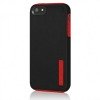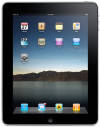Hi Tech Gadgets

iPhone Covers
Andy Fathollahi has been designing cases for mobile devices since 1999 starting with the Palm Pilot.
When he heard that Steve Jobs invented the iPhone he wanted to be the first to have a case for it.
Five months before it's release in January, 2007, Andy was in San Francisco to see the iPhone on display. He took pictures of it and began designing an iPhone case that would protect the device while allowing its features to be used.
He developed a prototype and filed a design patent. When Apple launched the iPhone, Andy's company, Incipio Technologies, started selling their iPhone case. It was a huge success.
In the first year revenue growth was 474 percent. Revenues continued to double every year (it's not a misprint - revenues doubled every year). He had to expand his facilities in Orange County a number of times - going from 9,000 square feet to eventually needing over 160,000 square feet of space.
His staff of four employees expanded to over one hundred and forty.
The incredible growth of his company earned Andy recognition as the Ernst & Young Entrepreneur of the Year.
The company had only one investor - Andy's proud mother.
Fathollahi developed a reputation for pursuing perfection in product creation and evolved his design process to support innovative thinking and attention to detail.
Using state-of-the-art 3D printers and materials, he can turn a hand-drawn sketch into a functioning prototype within a day.
 A good example of his product creation process is his bestselling Incipio Dual PRO for the iPhone 5.
A good example of his product creation process is his bestselling Incipio Dual PRO for the iPhone 5.
This iPhone cover features a hybrid design that combines a "soft touch" plextoniuim plastic hard shell with a impact absorbing silicone core.
The phone is fully protected while allowing access to all ports and controls with custom-cut holes around the lens and flash.
Source: incipio.com; photo credit: chapman.edu
Pocket Breathalyser
![]() If you drink alcohol don't operate a vehicle. But the reality is that people rely on their own sense of sobriety if they have a glass of wine at a restaurant or a couple of beers during a sporting event.
If you drink alcohol don't operate a vehicle. But the reality is that people rely on their own sense of sobriety if they have a glass of wine at a restaurant or a couple of beers during a sporting event.
The fact that blood alcohol levels differ for every person is what inspired this invention.
The iBAC alcometer is a thumb-sized, portable, breathalyser spectrometer that measures your blood alcohol content similar to tests done at a laboratory.
Here's how it works.
It transmits the breathalyser reading to your smartphone via Bluetooth where an application containing your bio data (such as your weight and other physical characteristics) analyzes the results in about a minute.
It will measure your degree of sobriety, your alcohol burning rate and will even forecast when you will have a zero level of alcohol in your body.
Source: alcosystems.se
PowerMat

The Powermat is a wireless charger for hi tech gadgets. You simply place your gadget on the mat to charge it.
It uses magnetic induction energy rather than electricity to charge devices and it works just as fast or faster than standard power adapters.
It can also charge multiple and different gadgets all at the same time.
Source: powermat.com
Gorilla Glass
 If there is one thing that consumers have in common when it comes to their hi tech gadgets - it's their concern about cracked and scratched screens.
If there is one thing that consumers have in common when it comes to their hi tech gadgets - it's their concern about cracked and scratched screens.
In fact, a whole industry has emerged to fix and replace the screens on smartphones, tablets, e-readers and other hi tech gadgets because they're a one-handed slip away from not being handheld.
But a product invented over 40 years ago is poised to become the latest and greatest screen technology for hi tech gadgets.
Gorilla glass, invented in the 60's by Corning Inc., is an utlra-thin, lightweight glass that is 3 times stronger than chemically strengthened glass and is extremely difficult to break, dent or scratch.
But when it was first invented there was no demand for such a product - until now. It's in demand because of the proliferation of digital devices.
Gorilla glass is currently used in more than 40 million mobile devices and is a $170 million a year business and expanding.
Beginning next year LCD frameless flat-screen televisions will also start using the glass. Corning expects revenues from their product to reach $200 million this year and over $1 billion next year.
Not bad for a product that has been in mothballs for 48 years.
Source: corning.com; ap.org photo: apple.com



